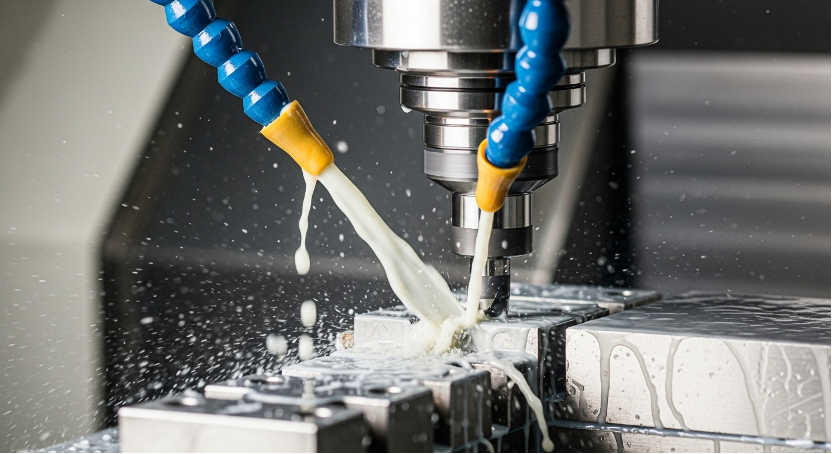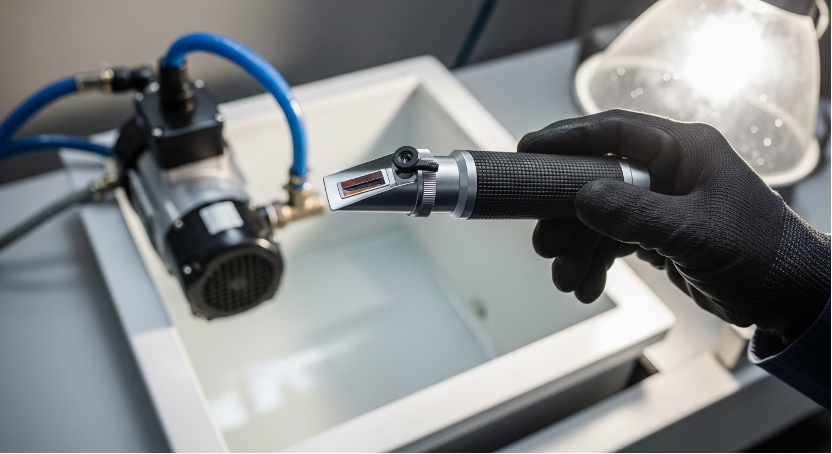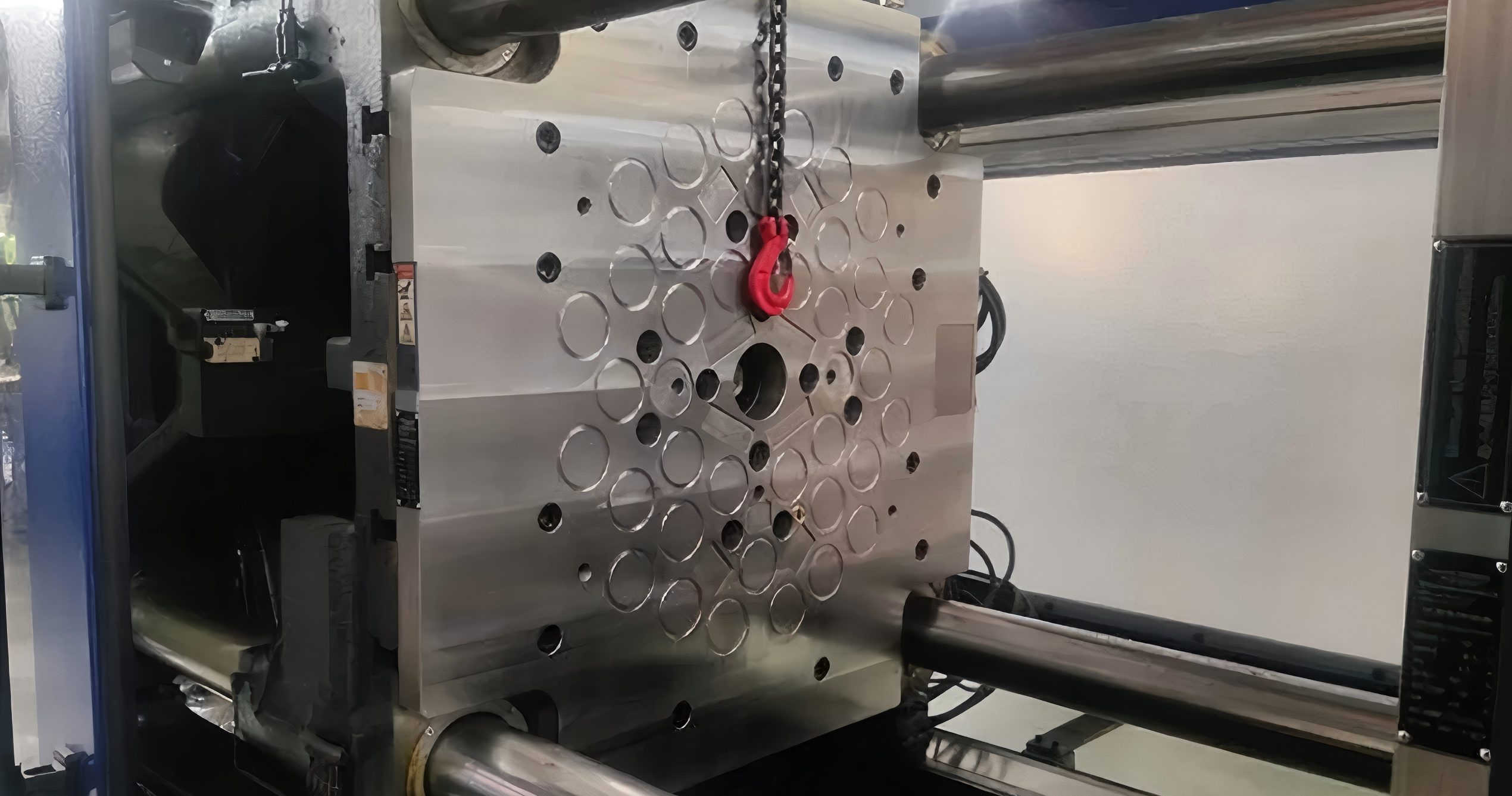
Johnny Xiong
Rapid Tooling Expert
Contents
If you ask ten people what makes CNC machining "precise," nine will point to the spindle, the controls, or the cutting tool. They're not wrong, but they're missing the single most critical, and most often neglected, component: the CNC coolant.
In my years on the shop floor, I’ve seen more catastrophic tool failures, scrapped parts, and mystery-finishing issues solved by fixing the coolant than by any other single change. It’s not an afterthought or just "water." It's a liquid cutting tool, and it's absolutely fundamental to modern machining.
This isn't just about keeping things from getting hot. The right coolant, managed correctly, is the difference between a stable, profitable process and a daily uphill battle. We'll cover what this fluid really is, why it's so critical, and—most importantly—how to manage it like a professional.

What is CNC Coolant and Why is It Critical?
At its most basic, a cutting fluid is a liquid delivered to the cutting zone. But its job is far more complex than just "cooling." It has three primary functions that must work in perfect balance:
- Thermal Stability (Cooling): Friction creates incredible heat. We're not just trying to stop the part from being hot to the touch; we're preventing the tool's cutting edge from annealing (losing its hardness) and the workpiece from "walking" (warping) due to thermal expansion.
- Friction Management (Lubrication): This is the big one. Coolant creates a high-pressure lubricating film between the chip and the tool. This prevents "built-up edge" (BUE), where material literally welds itself to the tool, which destroys surface finish and leads to tool failure.
- Process Reliability (Chip Removal): In a high-production environment, you can't have an operator clearing chips by hand. The coolant flow has to be strong enough to evacuate chips from deep pockets or drill holes, preventing them from being "re-cut"—a sure-fire way to break a tool or mar the part.
So, what is CNC coolant made of to accomplish all this? It’s a complex chemical package. Most are concentrates mixed with water, containing base oils (mineral or synthetic), emulsifiers, extreme-pressure (EP) additives, rust inhibitors, and biocides. Each ingredient has a job, and the blend determines what it's good at.
The Main Types of CNC Coolants
There's no "best" coolant, only the "right" coolant for the job. Choosing one is a trade-off between cooling and lubrication.
1. Soluble Oils (Emulsions)
This is the old-school, milky-white workhorse. It's a high concentration of mineral oil in an emulsified base.
- The Good: Unbeatable lubricity for the price. When you're doing heavy, slow-speed work on tough steels (like tapping or deep drilling), the high oil content is exactly what you need.
- The Bad: They are bacterial nightmares. The high oil content is food for microbes, so if you don't maintain your sumps, they will stink. Cooling is only "good," not "great."
2. Semi-Synthetic Coolants
This is the go-to for most modern job shops, and for good reason. It's a hybrid, with a lower oil content (5-30%) and a stronger synthetic chemical package.
- The Good: The "best of both worlds." You get good lubricity from the oil, but far better cooling and cleanliness than a soluble. They also last much longer and resist bacteria better.
- The Bad: They're a compromise. They don't have the extreme lubricity of a straight oil or the pristine cooling of a full synthetic.
3. Full Synthetic Coolants
These contain no mineral oil. They are pure chemical solutions that are often transparent.
- The Good: The undisputed king of cooling. Water is the best heat-transfer fluid, and synthetics are mostly water. They run incredibly clean, reject "tramp oil" (leaked machine oil) perfectly, and last a very long time. Think high-speed aluminum machining.
- The Bad: Very low lubricity. Don't ask a full synthetic to do heavy tapping in 316 stainless; it just doesn't have the film strength. They can also be tough on machine seals and paint if you get the wrong one.
4. Straight Oils (Neat Oils)
This is 100% oil, no water.
- The Good: Maximum lubricity, period. For the really tough jobs—think broaching, gun drilling, or machining exotic alloys on older machines—nothing lubricates better.
- The Bad: Cooling is terrible. All that oil is an insulator. They are messy, create a ton of smoke and mist, and are a significant fire hazard in high-speed CNCs. We rarely use them outside of very specific applications.

How to Select the Right Coolant for Your Project
Your coolant choice is driven by two things: the material and the operation.
1. Material is Everything:
- Aluminum: This is all about heat. When machining 6061-T6 at high RPMs, the material gets "sticky" and generates a lot of heat. You need maximum cooling. A full synthetic is an ideal choice here.
- Stainless Steel: This is all about lubrication. Materials like 304 or 316 are "gummy" and work-harden in a heartbeat. You need a high-lubricity fluid to prevent built-up edge and cushion the tool. A premium semi-synthetic or a soluble oil is the right call.
2. Operation Defines the Priority:
- High-Speed Milling/Grinding: Heat is the enemy. Prioritize cooling (Synthetics).
- Tapping, Reaming, Broaching: Friction and pressure are the enemies. Prioritize lubricity (Semi-Synthetics or Soluble Oils).
A quick word on safety. People always ask, is CNC coolant dangerous? It’s an industrial chemical and needs to be respected. The primary risks aren't from the fresh fluid, but from a poorly managed sump. Bacteria-filled coolant can cause dermatitis (skin irritation), and heavy oil mist isn't good to breathe. Good maintenance is good safety. Always wear gloves when handling concentrates and keep your sumps clean.
Coolant Management: Where Most Shops Fail
This is the part that separates the pros from the amateurs. You can buy the most expensive coolant on the market, but if you don't manage it, you've wasted your money.
1. Concentration is Non-Negotiable
This is the single most important maintenance task. You must use a refractometer (not just your eyes) to check the mix ratio every single day.
- Running Too Lean (too much water): This is a false economy. You'll save pennies on concentrate and spend dollars on new tools. You lose lubricity, rust protection, and you're inviting a massive bacteria bloom.
- Running Too Rich (too much concentrate): This is also bad. It's wasteful, gums up the machine, can cause skin irritation, and actually reduces cooling performance (oil traps heat).
2. Filtration and Cleanliness
Your sump is not a trash can. It needs to be kept clean. Two things will kill your coolant:
- Tramp Oil: This is the leaked hydraulic and way oil from the machine. It floats on top, seals the coolant from the air, and becomes an all-you-can-eat buffet for bacteria. Use an oil skimmer or coalescer to remove it constantly.
- Fines (Chips): Microscopic metal particles that the machine's conveyors miss. These get recirculated and turn your expensive coolant into a liquid-abrasive slurry, sandblasting your tools and part. This is where CNC coolant filtration systems become critical. Proper filtration isn't a "nice-to-have"; it pays for itself in extended coolant and tool life.
Our Approach to Coolant Strategy at HordRT
At HordRT, we treat coolant as a core part of our process engineering, not a janitorial task. Our approach is built on matching the fluid to the material and backing it with relentless maintenance.
Case 1: High-Volume 6061-T6 Aluminum
For a project like this, our strategy is built for speed and thermal stability. We select a premium full-synthetic coolant. We need to get heat out of the cut immediately to prevent chip-welding at high RPMs. This allows us to push our feed rates, reduce cycle times, and hold tight tolerances, as the clean-running synthetic leaves a pristine part finish with no oily residue.
Case 2: Complex 316 Stainless Steel
This is the opposite problem. 316 is tough, gummy, and will destroy a tool in seconds if the process isn't right. Here, our strategy is all about lubricity. We'll use a heavy-duty semi-synthetic with an advanced EP additive package. We're intentionally creating a thicker, more durable oil film to manage friction and stop that built-up-edge, ensuring we get consistent tool life and a smooth surface finish.
For us, the daily refractometer check, the pH monitoring, and the performance of our CNC coolant filtration and skimming systems are all production-critical data points.

Conclusion
In the end, coolant is an active, vital part of the cutting process. It's not just "liquid"; it's a tool that manages heat, pressure, and process stability.
The difference between a stable, predictable, and profitable machining operation and a shop that is constantly fighting finish issues and short tool life is often floating right in the sump. At HordRT, we understand that precision comes from controlling every variable—especially the one that touches everything.
If you're looking for a machining partner who truly understands the science behind the parts, talk to our team. We're ready to put our expertise to work for you.
-q4gvl4k29y4hq8j9rjpapvj0ft06fje63olt7p210i.png)


